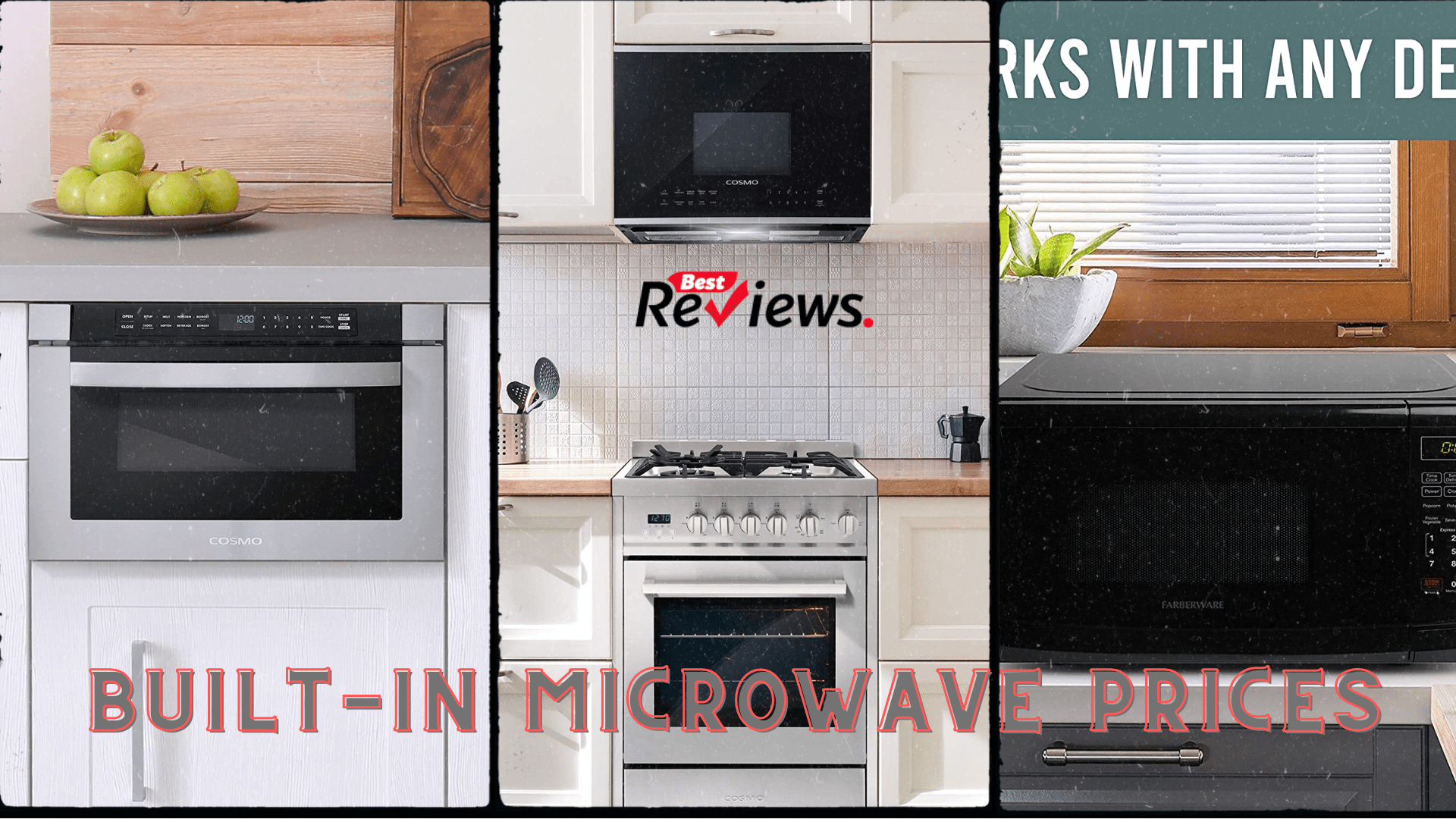A microwave oven is a useful kitchen device, and a built-in microwave takes convenience and utility to the next level with a sleek design that fits neatly on your wall or in your cabinet space.
Many built-in microwaves have the same outstanding capabilities as sophisticated countertop versions, such as steaming, grilling, and convection oven cooking settings. These counter space-saving appliances vary from simple versions to those loaded with many functions and unique door designs. However, sorting through the features and descriptions to discover the finest microwave for you may be a difficult chore.
That is why BestReviewsd is constantly on the lookout for the finest of the best. This shopping guide was intended to provide you with an overview of your choices and to assist you in determining which characteristics are most essential to you in a new microwave and the best built-in microwaves.
KEY CONSIDERATIONS
Conventional vs. convection cooking power
Microwaves are emitted by conventional models and pass through containers to heat food. The wattage of the microwave controls how rapidly it can heat the food. Because not all meals need 100 percent power to be heated, the power level on many models may be modified through a control panel. Conventional microwaves are the most affordable alternatives, however, they may still come with a plethora of additional functions.
Convection microwaves combine the benefits of convection cooking with traditional microwave technology. A radiant heat source circulates air within the microwave in combination with a fan. The air movement adjusts the heat, allowing the food to be fully and evenly cooked. These microwaves give results comparable to a convection oven. Notably, these units are more expensive than regular microwaves.
Power
A microwave’s power, measured in watts, determines how rapidly it can heat. Remember that a large-capacity microwave with low wattage will take longer to heat food than a small microwave with a high wattage. Built-in microwaves have wattages ranging from 800W to 1,200W.
Capacity
How much kitchen area do you require? Manufacturers indicate the physical capacity of a microwave in cubic feet. The smallest built-ins have a capacity of around 1 cubic foot, while the biggest has a capacity of approximately 2 cubic feet. The capacity you need is determined by how you intend to use your new microwave. If you want to make whole meals, a greater capacity will expedite the process. A small-capacity model may be suitable if you only cook for one or two people.
Some built-in microwaves are framed with a trim kit that comprises metal strips to hide the spaces between the microwave and the cabinetry. Others, however, do not need a trim kit and instead retreat into the cabinet.
FEATURES
Shortcut settings
Shortcut settings let you change power levels and cooking times for particular meals with a single button press. Some versions offer up to 100 pre-programmed cooking operations. The greater the price, the more shortcut settings accessible. You should also think about if you’re prepared to go through all of the culinary controls on the control panel to get the one you want.
Turntable
Turntables provide for more consistent cooking by rotating the food. Some variants include a removable turntable. In others, a rectangular tray moves back and forth throughout the cooking process. Models that enable you to toggle this function on and off provide you with greater control and alternatives while cooking. If you do not utilize the turntable, you may have to stop and turn the food manually as it cooks.
Variable power
Microwaves with variable power levels enable you to alter the power based on what and how much you’re cooking. You may require 30 to 50 percent electricity for defrosting or softening. Adjusting the power might help you avoid overcooking your meal.
Child safety lock
A child safety lock on a microwave door prevents children from messing with the microwave while also protecting them from being burnt. Child safety locks are particularly critical on radiant heat models since the food cooked in this method becomes quite hot.

Automatic sensor
This technology also referred to as a genius sensor (for example, in certain Panasonic products), monitors the amount of steam in the microwave and switches the oven off when the food is entirely cooked. This function is intended to avoid overcooking and undercooking while also eliminating the need for a timer. It is not, however, a fail-safe solution. The sensor might be thrown off by the temperature, volume, and density of the meal.
Microwave drawer
A microwave drawer expands your kitchen’s cooking area without taking up more counter space. Drawers are a relatively recent innovation to low-profile microwave design (usually at the height of your waist). When not in use, the drawer conceals away, however it does not rest flush with your cabinets.
When taking food from a microwave drawer, there is less pressure on the back, shoulders, and arms. Installed-in microwave drawers are often available in 24-inch variants that may be built into ordinary cabinets, as well as 30-inch ones that may need substantial modification or customization of the cabinetry to suit.
Grilling
A heating element is located on the top of the interior of built-in microwaves that can grill. These versions have a rack that brings food closer to the heating source when put in the microwave. This is a wonderful feature to look for if you want cook choices that replicate the flavor of grilled food.
Microwave grills are classified into two types: quartz and radiant. Quartz grills heat up quickly but are expensive. Only the most costly built-in microwaves are included. Radiant grills are more powerful, but they might take up to five minutes to heat up.
It is important to note that a microwave grilling rack is required. If you buy this style of microwave, it should come with a rack. If you don’t have a rack, you may be able to get one for your exact model on Amazon. However, you should carefully study the product description since racks come in various sizes and some are only designed for use in particular models.
DID YOU KNOW?Interlocks prevent the microwave from operating when the door is open. Most models come with a backup lock in case the primary one fails.
ACCESSORIES
Casserole dish: Pyrex Easy Grab
Pyrex’s inexpensive casserole dish has a glass top and a handle for easier handling. It is not only microwave safe, but it can also be used in the oven, freezer, and dishwasher.
Dinner plates: Colorful, microwave-safe tableware will liven up your table.
Splatter cover: ROSERAIN food cover
Try this ROSE RAIN spatter cover to prevent splatter messes and to cook/steam food more evenly. It is inexpensive and may be placed over a dinner plate, bowl, or another container to heat or reheat meals.
Bacon cooker: Emson Bacon Wave
With this convenient microwave attachment, older children can cook their own bacon without having to use heavy pots and pans. The Bacon Wave separates each slice of bacon as well as the fat drippings, resulting in a healthier breakfast alternative.
BUILT-IN MICROWAVE PRICES
Inexpensive
Built-ins with capacities ranging from 1 to 2 cubic feet and power ratings ranging from 800W to 1,200W may be found for less than $500. Some of these products come in many finishes and frequently contain automated sensors. (Sensor cooking reduces the possibility of overcooking.) These microwaves may also have a number of preset cooking choices or One-Touch controls. Although functionality is typically satisfactory, these appliances may lack the cosmetic appeal of more expensive built-ins.
Mid-range
The bulk of built-in microwaves cost between $500 and $1,000. To simulate the look of a wall oven, several of these types feature pull-down doors rather than swing-out doors. In this pricing range, you’ll also start to see some drawer-style built-ins. Fingerprint-resistant coatings are also becoming more popular in this price range.
Expensive
Built-in microwaves with all the bells and whistles cost more than $1,000. Sensors, grills, complex cooking choices, and up to 100 shortcut settings are common features of these devices. The aesthetic and design are excellent, with several drawer-type choices available in this top tier. These are the types that have the appearance of actual built-in wall ovens rather than microwaves. Notably, although some models seem attractive, their cooking durations are comparable to those of less costly ones.
Trim kits are not required for the installation of drawer-style built-in microwaves.

TIPS
- Some built-in microwaves require serious kitchen customization. Depending on the design of your kitchen, you may need an additional electrical outlet in the wall, which might raise the cost of installation.
- Fingerprint-resistant finishes are commonly seen on some stainless steel models. During our study, we discovered this beautiful and easy-to-clean smudge-proof feature supplied by respectable manufacturers like Samsung, Sharp, and Toshiba, to mention a few.
- A microwave with inverter technology renders more precision. Assume you wish to reheat some leftovers at 50% power. A microwave without inverter technology will alternately expose your food to 100% and 0% power, resulting in a “net impact” of 50% power. A microwave using inverter technology will reheat your food at 50% power rather than oscillating between the two extremes.
- Consider thawing frozen foods in the microwave with auto defrost. A microwave with an auto defrost mode heats frozen items much quicker than conventional techniques, such as leaving frozen meat in the refrigerator overnight.
- Use your microwave to keep warm food warm. For example, if you order takeout but aren’t quite ready to eat it, you may keep it warm in the microwave until you are. (Please keep in mind that food should not be left in the microwave for longer than a few seconds!) Furthermore, some sophisticated versions have a “keep warm” feature, which is also known as a “stay warm.”
- The air movement and radiant heat microwave browns and crisps food rather than making it turn soggy. A convection microwave oven may provide oven-like results if your cooking aims involve more than merely reheating food.
- Regardless of which built-in microwave you choose, keep the owner’s manual handy for quick reference. Register your product so you may be alerted of any recalls. It may also be simpler to get warranty reimbursement if you register your product, however, this is not always essential.
FAQ
Q. What’s the difference between a built-in and an over-the-range microwave oven?
A. While each of these microwaves uses cabinet space, their location differs. A built-in microwave oven does not need a hood or ventilation, but an over-the-range microwave oven must be able to vent steam and smoke from a cooktop. Over-the-range microwaves also offer range illumination. The variations, however, are largely visible on the outside. Both might have the same cooking technique and added functions.
Q. How much clearance do I need for a built-in microwave?
A. This is determined by the model, manufacturer, and size of the built-in. Swing-out doors need a greater distance to avoid colliding with other appliances or cabinet doors. Clearance requirements are often included in the handbook by the manufacturer.
Q. Do built-in microwaves come in different finishes?
A. Built-ins are available in a variety of finishes, including smudge-proof alternatives. While not all models are available in every finish, you can definitely find ones in white, black, or stainless steel.
Q. What does it mean to sensor cook?
A. No, however in the microwave world, there is considerable overlap between these two properties. As previously stated, a convection oven distributes heat to cook food more evenly. A microwave oven with sensors changes time and heat depending on humidity and moisture detected; it “auto cooks” until the food is cooked to perfection, removing the guesswork from microwave meal preparation. Many convection microwave ovens, but not all, contain auto cook sensors.


















